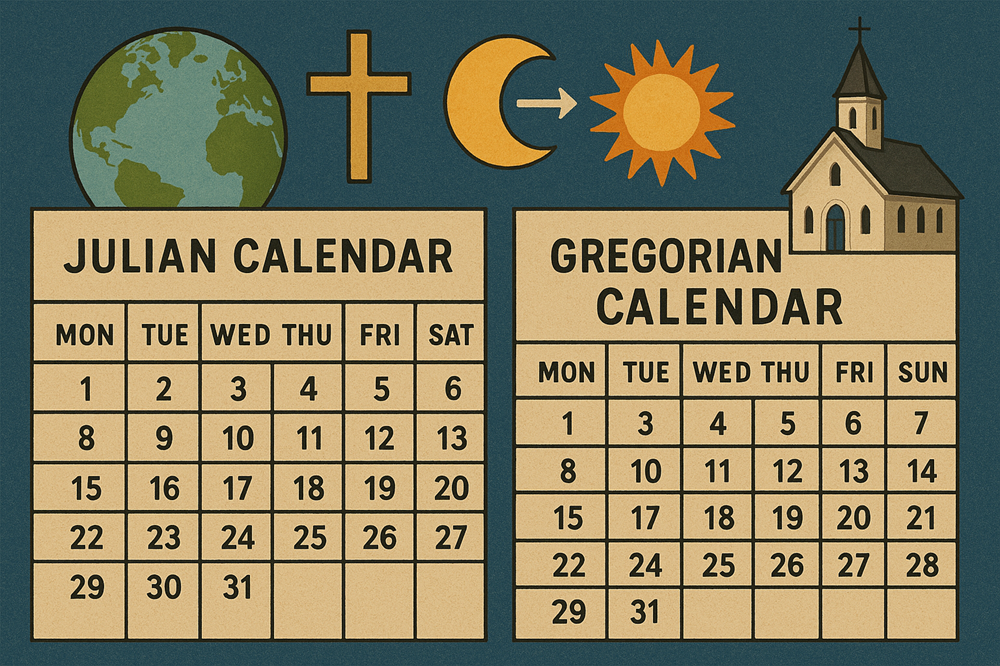
Difference Between Julian and Gregorian Calendars | Explained
The calendar is more than just a system of measuring days — it’s a reflection of astronomy, history, religion, and power. Two major calendar systems that shaped world history are the Julian and the Gregorian calendars.
Many people wonder why these calendars differ and why Eastern Orthodox Easter often falls on a different date than Western Easter. The root cause lies in the difference between these two calendars.
Let’s explore the origins, structure, differences, and historical implications of the Julian and Gregorian calendars.
What Is the Julian Calendar?
The Julian calendar was introduced by Julius Caesar in 45 BCE. It was based on a solar year, the time the Earth takes to complete one orbit around the Sun — approximately 365.25 days.
🔢 Key Features of the Julian Calendar:
- 365 days in a common year
- Leap year every 4 years (adds one extra day to February)
- Average year length = 365.25 days
This system was a vast improvement over earlier Roman calendars but still had a small error.
What Is the Gregorian Calendar?
The Gregorian calendar was introduced by Pope Gregory XIII in 1582 to fix a small but important error in the Julian calendar. Over centuries, the Julian calendar’s leap year rule had caused the calendar to drift away from the actual solar year.
🛠️ Gregorian Reform Adjustments:
- Leap year rule modified:
- A year is a leap year if divisible by 4
- Except if divisible by 100, unless also divisible by 400
- Dropped 10 days from the calendar in 1582 to realign it
- Introduced new rules for calculating Easter based on a more accurate equinox
🔢 Average year length in Gregorian Calendar:
365.2425 days — much closer to the actual solar year
Key Differences Between Julian and Gregorian Calendars
| Feature | Julian Calendar | Gregorian Calendar |
|---|---|---|
| Introduced By | Julius Caesar (45 BCE) | Pope Gregory XIII (1582 CE) |
| Average Year Length | 365.25 days | 365.2425 days |
| Leap Year Rule | Every 4 years | Every 4 years, except centuries not divisible by 400 |
| Calendar Drift | ~11 minutes per year | Reduced drift significantly |
| Used By Today | Eastern Orthodox Churches, some countries | Most of the world |
| Correction Made | None | Dropped 10 days in 1582 |
Why Was the Gregorian Reform Necessary?
The Julian calendar was 11 minutes too long each year. Over time, this caused the spring equinox to shift earlier, affecting the date of Easter.
By the 16th century, the equinox had drifted by about 10 days, and Easter was being celebrated at the wrong time.
The Gregorian reform:
- Re-established the March 21 vernal equinox
- Aligned Easter with the Council of Nicaea’s rules (325 AD)
Adoption of the Gregorian Calendar
✝️ Catholic Countries:
- Adopted quickly in 1582 (e.g., Spain, Portugal, Italy, Poland)
🏴 Protestant Countries:
- Initially resisted the change
- England adopted it in 1752, dropping 11 days
🧑🌾 Eastern Orthodox Churches:
- Continued using the Julian calendar, particularly for religious festivals
- Hence, Orthodox Easter often falls on a different date than Catholic/Protestant Easter
Calendar Drift Today
- The Gregorian calendar still has a slight error (~27 seconds/year) but it is much more accurate.
- Over 3,000 years, it will drift by only one day.
Impact on Easter and Religious Holidays
One of the most noticeable impacts of the calendar difference is on Easter:
- Western Churches use the Gregorian calendar for calculating Easter
- Eastern Orthodox Churches use the Julian calendar for both Easter and fixed feasts
Example:
In 2025, both calendars align — Easter will fall on April 20, 2025 for both traditions, which is rare.
📚 Related Articles (Internal Linking Suggestions)
Final Thoughts
The difference between the Julian and Gregorian calendars may seem small, but it has had major religious, political, and cultural impacts. Understanding this difference helps explain why Easter dates vary, why some holidays differ across regions, and how astronomy and faith intersect in calendar systems.






